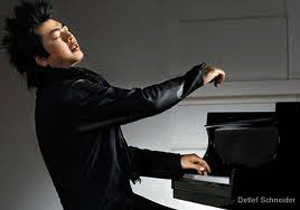Lang Lang gave a phenomenal concert at Carnegie Hall, broadcast live on WQXR on May 29th, 2012. He is without a doubt the most famous pianist in the world, continuing to perform to sold out houses in every city he plays. In 2009, he appeared in Time Magazine’s annual list of the 100 Most Influential People in the World. The Year before, more than four billion people saw his performance during the opening ceremonies of the Beijing Olympic Games, inspiring over 40 million Chinese children to learn to play classical music on the piano. He just received an Honorary Doctorate Degree from the Manhattan School of Music in recognition of his extraordinary accomplishments as a musician, educator, and musical ambassador to the world. Lang Lang may very well be the most popular classical musician on the globe, and it isn’t difficult to see why. There was an excitement in the air before the concert began, with a sold out house, including some 120 stage seats. Thankfully, the live broadcast on WQXR is still available by typing in WQXR.org Lang Lang. This was the first time he was performing Bach in Carnegie Hall, and there were video cameras and microphones surrounding the stage; talk about pressure! Yet he played comfortably and intimately, as if in his living room. Oddly, the only noticeable minor slips were in the Gigue of the Bach Partita, where the left hand crosses over the right in a fast tempo. In the slow Sarabande, Lang Lang used rubato to be expressive, but in Baroque music he needs to do this while playing in time, which he did in all the other movements. Still, his playing was much more natural than the Bach of Glenn Gould, who was considered the greatest “Bach Specialist”.
Next on the program was the last sonata of Schubert, written in the year of his death, 1828. Interestingly, it is in the same key as the Bach Partita (B-flat Major), and it also presents itself with a quiet simplicity. His performance was filled with an abundance of colors, as he has tremendous control over the piano. He defines the epitome of technique: the ability to do anything you want at the instrument. He can play incredibly softly, yet his sound still carries to the last row in the hall. Of course, nobody can please everybody; that was the case with Glenn Gould, Leonard Bernstein, and Daniel Barenboim, but Lang Lang comes close to pleasing most audiences at only 29 years of age. His newfound demeanor has changed his concert attire, his repertoire, and his maturity. That is not to say he doesn’t have to develop more; he still could play with more simplicity and let the music speak for itself. Gary Graffman was Lang Lang’s teacher at the Curtis Institute in Philadelphia from the time he was 14 until 19. Mr. Graffman said that Lang Lang sent a DVD performance of all 24 Chopin Etudes when he was 13 or 14 years old! At this Carnegie performance, the Etude in Thirds was so stupendous that it elicited bravos from the audience, which then broke into consistently boisterous applause, which gave him a moment to wipe his brow. He quickly continued with the difficult “Winter Wind Etude”, which was indeed fabulous. As if to prevent more applause, he dove into the last etude, the “Ocean”.
At the conclusion, the audience went wild, jumping to their feet screaming “Bravo!” The first of the two Liszt encores was a Romance in E Minor, which was lovingly performed, and it was followed by “La Campanella,” which was nothing short of stupendous. He could have gone on and on, but the house lights went up, signaling that it was the end to one of the best recitals I have ever heard.

